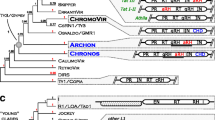Summary
We have used the polymerase chain reaction (PCR) to isolate a sequence characteristic of aTy1-copia group retrotransposon from the genome of the herring (Clupea harengus). This is the firstTy1-copia group retrotransposon sequence described in a vertebrate. Phylogenetic comparison of this sequence with other members of this group of retrotransposons shows that it resembles more closely some Tyl-copia group members fromDrosophila melanogaster than other group members in plants and fungi. These observations provide further evidence that theTy1-copia group LTR retrotransposons span many of the major eukaryote species boundaries, suggesting that horizontal transmission between different species has played a role in the evolution of this retrotransposon group.
Similar content being viewed by others
References
Bingham PM, Zachar Z (1989) Retrotransposons and the FB element fromDrosophila melanogaster. In: Berg DE, Howe MM (eds). Mobile DNA. American Society for Microbiology, Washington DC, pp 485–502
Boekc J (1989) Transposable elements inSaccharomyces cerevisiae. In: Berg DE, Howe MM (eds). Mobile DNA. American Society for Microbiology, Washington DC, pp 335–374
Daniels SB, Strausbaugh LD, Ehrman L, Armstrong R (1984) Sequences homologous to P elements occur inDrosophila paulistorum. Proc Natl Acad Sci USA 81:6794–6797
Devereux J, Haeberli P, Smithies O (1984) A comprehensive set of sequence analysis programs for the VAX. Nucleic Acids Res 12:387–395
Doolittle RE, Feng DF (1990) Nearest neighbour procedure for relating progressively aligned amino acid sequences. Methods in Enzymol 183:659–669
Doolittle RE, Feng DF, Johnson MS, McClure MA (1989) Origins and evolutionary relationships of retroviruses. Quar Rev Biol 64:1–29
Feng DF, Doolittle RE (1987) Progressive sequence alignment as a prerequisite to correct phylogenetic trees. J Mol Evol 25:351–360
Flavell AJ (1992) The evolution ofTy1-copia group retrotransposons in cukaryotes. Genetica 85: (In press)
Flavell AJ, Smith DB, Kumar A (1992) Extreme heterogeneity ofTy1-copia group retrotransposons in plants. Mol Gen Genet 231:233–242
Grandbastien M-A, Spielmann A, Caboche M (1989)Tnt1, a mobile retroviral-like transposable element of tobacco isolated by plant cell genetics. Nature 337:376–380
Grandbastien MA (1992) Retroclements in higher plants. Trends Genet 8 : (in press)
Higgins DG, Sharp PM (1988) CLUSTAL: a package for performing multiple sequence alignment on a microcomputer. Gene 73:237–244
Houck MA, Clark JB, Peterson KR, Kidwell MG (1991) Possible horizontal transfer ofDrosophila genes into the miteProctolaelaps regalis. Science 253:1125–1129
Konieczny A, Voytas DF, Cummings DF, Ausubel FM (1991) A superfamily ofArabidopsis thaliana retrotransposons. Genetics 127:801–809
Miller DW, Miller LK (1982) A virus mutant with the insertion of acopia-like transposable element. Nature 299:562–564
Mizrokhi LJ, Mazo AM (1990) Evidence for horizontal transmission of the mobile element jockey between differentDrosophila species. Proc Natl Acad Sci USA 87:9216–9220
Rothnie HM, McCurrach KJ, Glover LA, Hardman N (1991) Retrotransposon-like nature of Tpl elements: implications for the organization of highly repetitive, hypermethylated DNA in the genome ofPhysarum polycephalum. Nucleic Acids Res 19:279–286
Teich N (1984) Taxonomy of retroviruses. In: Weiss R, Teich N, Varmus H, Coffin J (eds) RNA tumor viruses. Cold Spring Harbor Laboratory Press, Cold Spring Harbor, New York
Temin HM (1980) Origin of retroviruses from cellular moveable genetic elements. Cell 21:599–600
Varmus HE, Brown P (1989) Retroviruses. In: Berg DE, Howe MM (eds). Mobile DNA. American Society for Microbiology, Washington DC, pp. 53–108
Xiong Y, Eickbush TH (1990) Origin and evolution of retroelements based upon their reverse transcriptase sequences. EMBO J 9:3353–3362
Yuki SS, Ishimaru S, Inouye S, Saigo K (1986) Identification of genes for reverse transcriptase-like enzymes in twoDrosophila retrotransposons,412 and gypsy; a rapid detection method of reverse transcriptase genes using YXDD box probes. Nucleic Acids Res 14:3017–3030
Author information
Authors and Affiliations
Rights and permissions
About this article
Cite this article
Flavell, A.J., Smith, D.B. ATy1-copia group retrotransposon sequence in a vertebrate. Molec. Gen. Genet. 233, 322–326 (1992). https://doi.org/10.1007/BF00587596
Received:
Issue Date:
DOI: https://doi.org/10.1007/BF00587596




